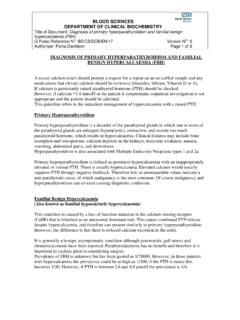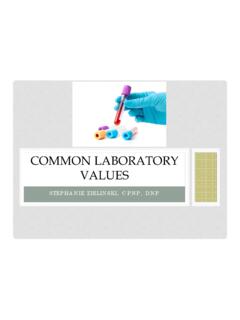Transcription of KIDNEY STONE & URINE ANALYSIS - Kazmis
1 Falling Hair Problems & Probable 12 January 2011 1 KIDNEY STONE & URINE ANALYSIS The Urinalysis: The urinalysis measures the presence and amount of a number of chemicals in the URINE , which reflect much about the health of the kidneys, along with cells that may be present in the URINE . We try to identify crystals, bacteria, yeast, red cells, white cells (indicating infection), something called a cast (which is a clump of sloughed cells from inside the tiny renal filtration tubules), sperm and even the occasional parasite.
2 This lets us know if we are dealing with infection, diet or metabolism disorders, and what part of the urinary system is in trouble. Also, veterinarians or in human medicine the lab, looks for crystals, bacteria, and other organisms in the urinary sediment. Each of these elements give hints as to function of the kidneys, KIDNEY tubules, ureters (small tubes that connect the kidneys with the urinary bladder), and the urinary bladder. The first part of a urinalysis is direct visual observation. Normal, fresh URINE is pale to dark yellow or amber in color and clear.
3 Normal URINE volume is 750 to 2000 ml/24hr. Turbidity or cloudiness may be caused by excessive cellular material or protein in the URINE or may develop from crystallization or precipitation of salts upon standing at room temperature or in the refrigerator which is usually of no significance. Clearing of the specimen after addition of a small amount of acid indicates that precipitation of salts is the probable cause of turbidity. URINE is normally transparent in most animals, except for the horse. The horse has a thick viscous URINE that is cloudy on examination.
4 In small animals, turbidity suggests the presence of cells, casts, or crystals. A red or red-brown (abnormal) color could be from a food dye, eating fresh beets, a drug, or the presence of either hemoglobin or myoglobin. If the sample contained many red blood cells, it would be cloudy as well as red. URINE Odor: URINE has a characteristic smell that varies slightly by species and concentration of the sample. A particularly foul odor may occur in the presence of bacteria. Thus, strong smelling URINE is common in cases of cystitis.
5 Ketonuria (ketones are produced when tissues are breaking down like in the process of starvation) produces a very sweet smell Falling Hair Problems & Probable 12 January 2011 2 as does Glucosuria (sugar in the URINE from diabetes). Sweet smelling URINE is commonly associated with acetonemia (acetones in the URINE ), pregnancy toxemia, and diabetes mellitus. Urinary Dip Stick Test: URINE tests are typically evaluated with a reagent strip that is briefly dipped into the URINE sample. The technician reads the colors of each test and compares them with a reference chart.
6 Glucose (test for diabetes) Bilirubins (tests for liver disease and biliary obstructin) Ketones (tests for fat breakdown products, insulin deficiency, starvation) Specific gravity (to see if the KIDNEY is concentrating the URINE ) Blood (infection or irritation) pH (tells us what kinds of stones may be present if this is abnormal additional test gives more information) Protein (tests for integrity of the filtering system) Urobininogen Nitrites (a test for some bacterial infections) Leukocytes (White blood cells indicating infection or cancer) URINE Sediment: The URINE is then spun down and the sediment checked for cells, yeast, bacteria, crystals, and casts (groups of dead cells that indicate KIDNEY tubule damage).
7 We ll talk about those below. Here are some tips on collecting the URINE sample: If you are doing a free-catch sample, it is nice to have some URINE caught in the beginning, middle and end of the urination process. Why? The first fraction coming out flushes cells, yeast and bacteria from the vulva or prepuce areas and the urethra (the tube that connects the bladder to the outside world). The middle fraction is a better picture of what has been stored in the bladder. The tail-end of the sample gives a better idea of how the kidneys look.
8 Falling Hair Problems & Probable 12 January 2011 3 My personal choice as a veterinarian is to stick a long needle directly into the bladder so I don't have to guess if the bacteria, yeast and dead cells are from the urethra or the bladder. It doesn't hurt much and helps alleviate contamination of the sample. That way I can treat the core cause instead of a secondary infection of some type. Medical doctors sometimes insert a catheter into the bladder for this reason. If you are trying to get a sample from your pet at home, one easy way to do it is to tape a small cup to the bottom of the ruler.
9 As the pet urinates, you can slip the cup underneath them without leaning over and startling them. Label the sample with the date and time it was collected then get the sample to your vet right away for testing. URINE Volume: Increased URINE Volume (Polyuria): Rule out acute renal disease, chronic renal disease, diabetes mellitus hepatic failure, hyperadrenoorticism, hypercalcemia, hyperparathyroidism (cats and humans), nephrogenic diabetes insipidus, pituitary diabetes insipidus, post obstructive diuresis, primary renal glyosuria, psychogenic polydipsia, pyelonephritis, and pyometra.
10 Decreased URINE Volume (Oliguria): Rule out acute renal failure, dehydration, shock, terminal chronic renal disease, and urinary tract obstruction. pH: pH is a measure of hydrogen ion concentration (acidity or alkalinity) of the URINE . Fresh samples are necessary for an accurate reading because URINE becomes alkaline when it is older because the carbon dioxide escapes and the bacteria in the URINE convert urea to ammonia which is very alkaline. The healthy, normal pH of human URINE is less than 7. The glomerular filtrate of blood plasma is usually acidified by renal tubules and collecting ducts from a pH of to about 6 in the final URINE .







